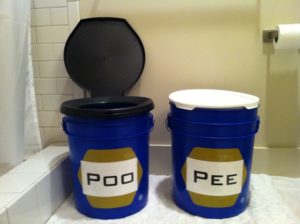
About: Emergency sanitation is the management and technical processes required to provide sanitation in emergency situations. This can include man-made or natural disasters. Emergency sanitation is also required during humanitarian relief operations for refugees and Internally Displaced Persons (IDPs). Emergency situations are classified into three phases which are called the “immediate”, “short-term” and “long-term” phases. In the immediate phase, the focus is on reducing open defecation. Toilets provided might include very basic latrines, pit latrines, bucket toilets, container-based toilets or chemical toilets. Providing showers and hand washing facilities is also part of emergency sanitation during all phases. Fecal sludge management becomes a priority during the long-term emergency management phase.
Background: The term “Emergency” is perceived differently by different people and organizations. In a general sense, an emergency may be considered to be a phenomenon originating from a man-made and/or natural disaster which results in a serious, usually sudden threat to the health or well-being of the affected community which relies on external assistance to easily cope up with the situation. There are different categories of emergency depending on its time frame, whether it lasts for few weeks, several months or years.
Methods: To address the problem of public health and the spread of dangerous diseases that come as a result of lack of sanitation and open defecation, humanitarian actors focus on the construction of, for example, pit latrines and the implementation of hygiene promotion programmers. The supply of drinking water in an urban-setting emergency has been improved by the introduction of standardized, rapid deployment kits. In the immediate emergency phase, the focus is on managing open defecation, and toilet technologies might include very basic trench latrines, pit latrines, bucket toilets, container-based toilets, chemical toilets. The short term phase might also involve technologies such as urine-diverting dry toilets, septic tanks, decentralized wastewater systems.
Settings: The emergency response often has to differ greatly based on the setting it takes place.
Home based: Home based settings where people choose to stay in or close to their homes (or those of their relatives, neighbors or friends). While this setting offers the quickest way to (self) recovery, it also poses a high risk of sanitation related impacts due to the common lack of access to outside help and inadequate public-health monitoring.
Host community: Host community settings with significant displacement into outside communities (usually urban) with existing but maybe also effected sanitation infrastructure in private homes. Existing infrastructure in such settings is usually quickly overloaded due to the increase in population density and improvements/repair is often hindered by access- and space-limitations. Intra-community conflicts over the sanitation waste management are thus fairly common.
Mass shelter: Mass shelter settings where the displaced population is housed in existing but often re-purposed building-complexes such as schools, community centers’, places of worship, malls, warehouses and sport stadiums. In some disaster prone countries, dedicated large emergency shelters are build for this purpose. Existing sanitation facilities are usually inadequate for full-time stay of a high number of people, and the non-emergency management structures are typically unable or unwilling to continue their services.
Emergency settlements: Emergency settlements (formal or informal) where previously sparsely populated areas are newly occupied by the displaced population in large numbers. Typically these are set up by governments, the UN and humanitarian aid organizations. Due to the typically short time frame of arrivals and the non-existing infrastructure, these kind of encampments pose maybe the greatest challenge in regards to providing adequate emergency sanitation facilities.
Challenges: Emergency pit lining kits, suitable for areas with high water table. The provision of sanitation programmers is usually more challenging than water supply as it provides a limited choice of technologies. This is exacerbated by the overwhelming and diverse needs of WASH. Challenges with excreta disposal in emergencies include:
- Building Latrines in areas where pits cannot be dug, dislodging latrines, no-toilet options and the final treatment or disposal of the fecal sludge.
- Weak community participation and finding hygiene promotion designs that are suitable for a given context to make the WASH interventions sustainable.
- Newly arriving IDP or refugee populations can usually only be settled in less than ideal Ares, such as land that is prone to regular flooding or which is very dry and with rocky ground. This makes the provision of safe sanitation facilities and other infrastructure very difficult.
- In long running emergencies, the safe decommissioning or dislodging of previously quickly built sanitation facilities can also become a serious challenge.
- Humanitarian actors need to understand the importance of better preparation and resilience and the need for exit strategies and have consideration on the environment.






